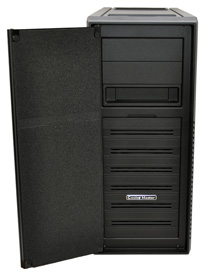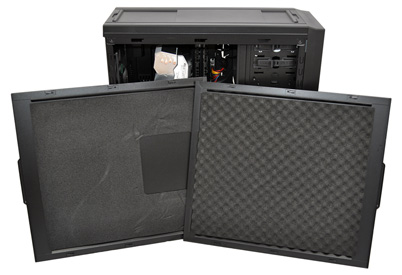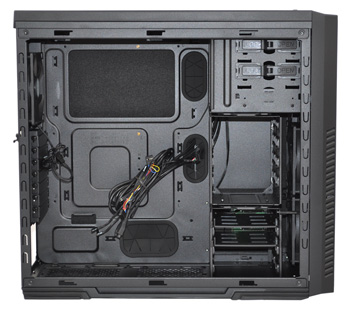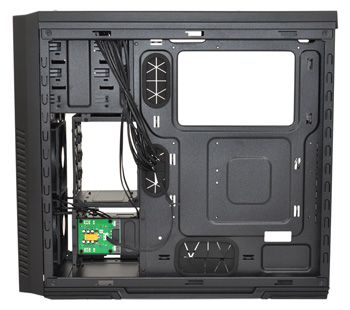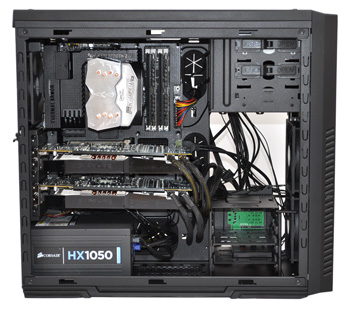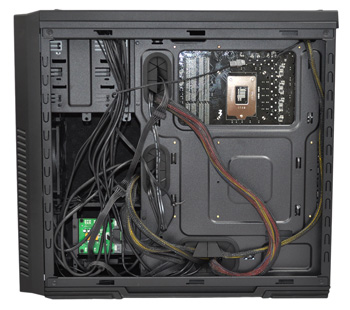Inside the Silencio 650
As with most enclosures, it's on the inside that the fun really starts. Opening the Silencio 650's front door and removing the side panels provides the first real glimpse at the chassis' sound-proofed credentials. The side and front panels are all adorned with sound-deadening material, but not all of the same quality. The foam padding on the left side panel is noticeably thicker than the padding on the right; Cooler Master presumably wanted to leave as much room behind the motherboard tray as possible.
The roof of the chassis also comes equipped with a small pad of foam, though its usefulness is questionable - the top-rear fan mount is left uncovered, as is the area above the optical drive bays.
Still, there's enough padding on show here to dampen a good amount of noise and, like the top I/O panel, the chassis' front is well-stocked with features. Behind the sturdy aluminium door, a plastic clip-off cover provides easy access to the two front intakes - as well as the dust filter protecting them - and two tool-free 5.25in optical drive bays. In between all that, Cooler Master has also squeezed in an external hot-swappable drive bay. A 3.5in drive will slot right in, but what's handy is that a 2.5in tray is included as part of the bundle, making it easy to slide in - and, more importantly, slide out - a high-speed SSD.
The all-black internal cavern isn't lacking in extra touches, either. The expansion-slot brackets are all held in place with easy-to-open thumb screws, the power supply bay is padded with rubber standoffs, the motherboard tray is equipped with three well-sized and rubber-grommeted cable-routing holes, as well as two up-and-over holes and a large cutout to help with CPU cooler installation.
It isn't the most expansive exterior we've seen in a mid-tower frame, but it can be made to feel more roomy by removing the middle hard-disk cage - it's designed to hold four drives but can be pulled out after undoing a couple of screws, to leave the user with three remaining bays. That's likely to be ample for most, and the three bottom-most bays have a trick up their sleeve, too. Two of the three back onto a pre-installed PCB that gives the Silencio 650 its dual-boot functionality.
We're not sure how popular this particular feature will prove to be, but some will no doubt find it useful - especially if you're itching to try Windows 8 without letting go of the OS you're currently using. Using two drives, the Silencio 650 would be able to switch between boot devices using the toggle on the top I/O panel.
Cooler Master also provides two drive bays that support 3.5/2.5in drives - so either form factor can be easily attached to the dual-boot PCB - but the six remaining drive bays are 3.5in only; rails are included in the bundle to make installation as easy as clip-and-go.
Cooling, meanwhile, is fairly straightforward. Two 120mm intakes pull cool air in from the front, and a single 120mm rear exhaust lets hot air out the back. All three bundled fans are designed to run at speeds of up to 1,200 RPM, but hooking them up to the integrated fan controller makes it easy to reduce the rotational speed to a quieter 700 RPM. Though, there doesn't appear to be any room in between; it's either high speed or low speed.
The out-the-box configuration is likely to be adequate, but provisions have been made for further expansion. As we've already mentioned, a 120/140mm exhaust can be added up top, and in addition to that there's room for a 120mm fan at the bottom (though it'll be a squeeze with large PSUs) and a 120mm fan can be added to the side of the removable drive tray (though doing so will certainly impinge on GPU clearance).
The feature set is attractive and for the most part there's more than enough room for a high-end build. Our test platform consists of an ASUS Sabertooth Z77 motherboard, an Intel Ivy Bridge processor and dual Sapphire Radeon HD 7950 OC graphics cards in CrossFire. All the components fit in well and by taking away the removable hard-disk cage, there's plenty of space for at least one extra-long graphics card. GPU clearance is officially specified as 268mm with the hard-disk cage installed, or 434mm with the cage removed. CPU cooler clearance is decent, too, with the maximum available height listed as 168mm; more than enough for our Arctic Cooling Freezer 13.
Building into the Silencio 650 isn't a problem - it's all straightforward enough - but cabling can get messy and it isn't helped by the chassis' various features. The front-facing hot-swap bay requires a SATA data cable and a Molex power cable, and on top of that the dual-boot PCB requires another Molex power connection as well as two further SATA data cables.
Of course, you don't need to use all of these features - and most users probably won't - but fill the Silencio 650 with high-end hardware and a couple of graphics cards, and the cable clutter is hard to get around. There isn't a great deal of room between the motherboard tray and the side panel - we found it tricky to get the side panel on at all due to cable clearance - and though there are plenty of opportunities to tie cables down, creating a clean-looking build isn't an easy task.
The chassis could do with being a bit thicker, and it's a shame Cooler Master didn't sacrifice CPU cooler clearance by raising the motherboard tray a centimetre or two; doing so would have provided more room for excess cables. But anyhow, good features, an easy install and modest aesthetics are going to count for nothing if performance isn't up to scratch. Let's find out how quiet the Silencio 650 really is, and whether or not its three standard fans are able to cool adequately.






